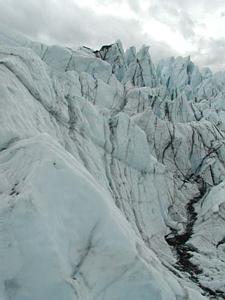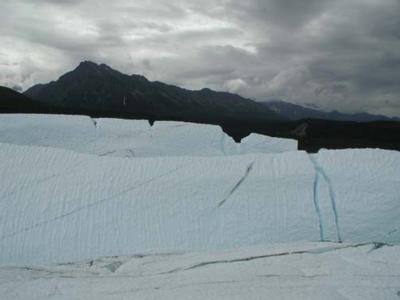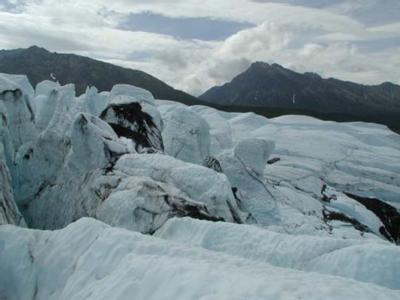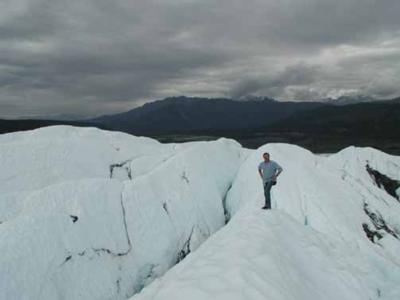23 July, 2000
July 23, 2000
Matanuska Glacier, Alaska
One of the most vivid memories that I will have of this glacier is how
dynamic it is, at least during the warm summer months. In my journal on
July 12 I mention that a day visitor would have no clue as to how much
it changes from day to day. And for my part I similarly have no direct
observations about the big changes that occur in the glacier as it
moves, changes that may be incrementally small but occurring over long
periods of time. I know that glaciers move along rather slowly most of
the time. This cannot be observed casually but the type of motion and
the changes caused by that motion are extremely interesting. As I move
about the area I can only observe some of the many changes that the
glacier has on the landscape. It would be very interesting to actually
see the motion of the ice in fast forward motion.
For any glacier the terminus may be stationary, retreating uphill or
advancing downhill. In any case the ice within the glacier is constantly
moving downhill. Within the glacier there are differences in the speed
with which the ice moves. If the temperature of the ice at the base of
the glacier is much below the freezing point the ice bonds tightly to
the rock and cannot move. This occurs in polar regions such as
Antarctica and Greenland as well as during winter months for others and
even high altitudes in the summer months. But even when the bottom is
motionless, the ice in the deepest layer, near the basal layer, deforms
as ice crystals warp and slip past one another. This deep ice is
subjected to the greatest stress due to the weight and resulting
pressure from all the ice above. The greater the pressure the more the
glacial ice will be deformed. As you move nearer to the surface this
stress is continually decreasing and less deformation occurs. This
deformation is most easily accomplished in warm ice. During the winter
months when the ice near the surface is colder it is not as easily
deformed but is much more brittle that the deeper ice. As a result many
crevasses form whenever changes in stress are too great for the
deformation to keep up with.
During summer, meltwater seeping down into the cracks and moulins warms
any subfreezing temperature ice and eventually the entire glacier is at
roughly the same temperature. The deep basal layer warms up near its
melting point.Thawing and refreezing allows water at the interface
between ice and rock to act as a lubricant and the glacier can now slide
on its bed. With the ice near its melting point the high pressure
created when ice pushes on a rock surface serves to lower the melting
point of the ice. This liquid water will creep along until it reaches an
area of low pressure where it will refreeze again. In addition to this
slipping the warmer summer ice is more quickly deformed and “flows” more
quickly. As a result the forward motion of the glacier in the summer
occurs at a quicker pace than during the cold winter months. In either
season the ice at the top of the glacier will move faster than the lower
ice, resulting in the many cracks and crevasses on the surface of the
glacier.
I mentioned on July 17 that glaciers at one time extended to my hometown
in southern Indiana. The best way to picture a glacier moving that far
without a significant drop in elevation is to consider that glaciers
flow much more slowly, but in a similar fashion to poured honey. If you
were to pour honey in one spot on a table it would well up and move
slowly outward from the center. If you used refrigerated honey it would
behave the same way but much more slowly. The glacier that advanced
across most of Indiana and the upper Midwest did so like ultra-slow
honey. As more and more snow accumulated in the polar regions it
produced the pressures necessary to cause the ice to deform slowly and
begin to “flow” and move southward. As the ice advanced it scraped and
scoured the land just as the Matanuska Glacier is doing now, leaving
behind landforms and deposits that look similar to those I can observe
here.
Marvin Giesting

A wall of seracs with debris filled cracks.

Continuous cracks running perpendicular through adjacent parallel ridges.

Highly fractured, impassable portions of the glacier.

I'm standing on one of several narrow, parallel ridges produced in the upper layers of glacial ice near the terminus. This upper ice gets much colder in winter and is subject to fracturing more easily under stress.
Contact the TEA in the field at
.
If you cannot connect through your browser, copy the
TEA's e-mail address in the "To:" line of
your favorite e-mail package.
|
